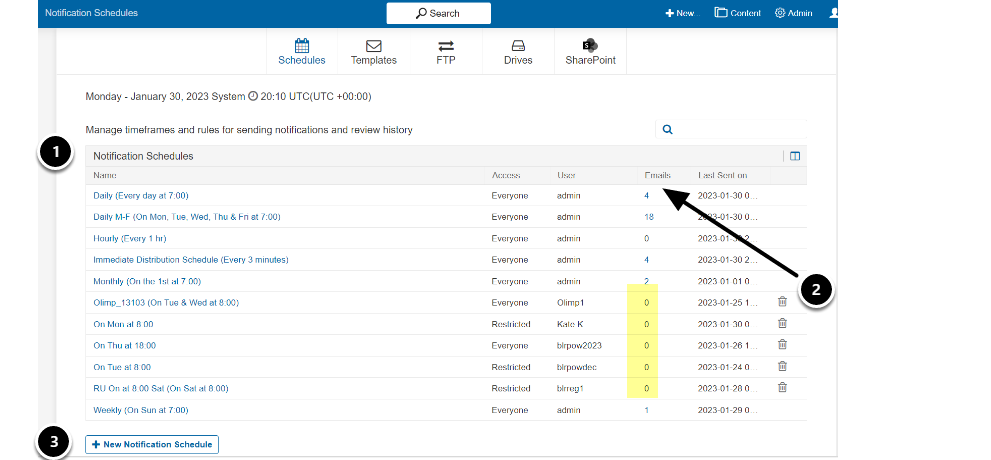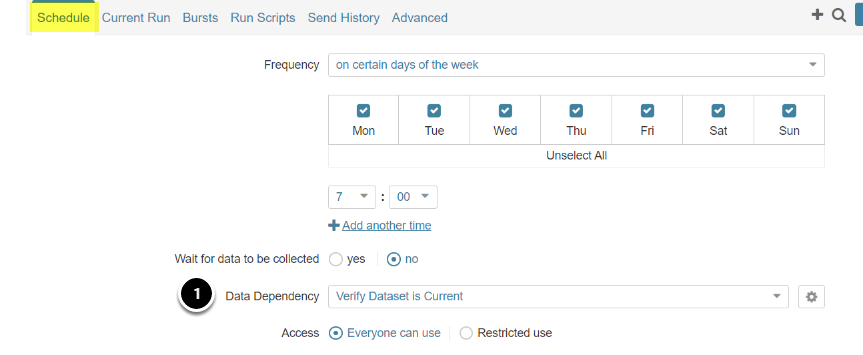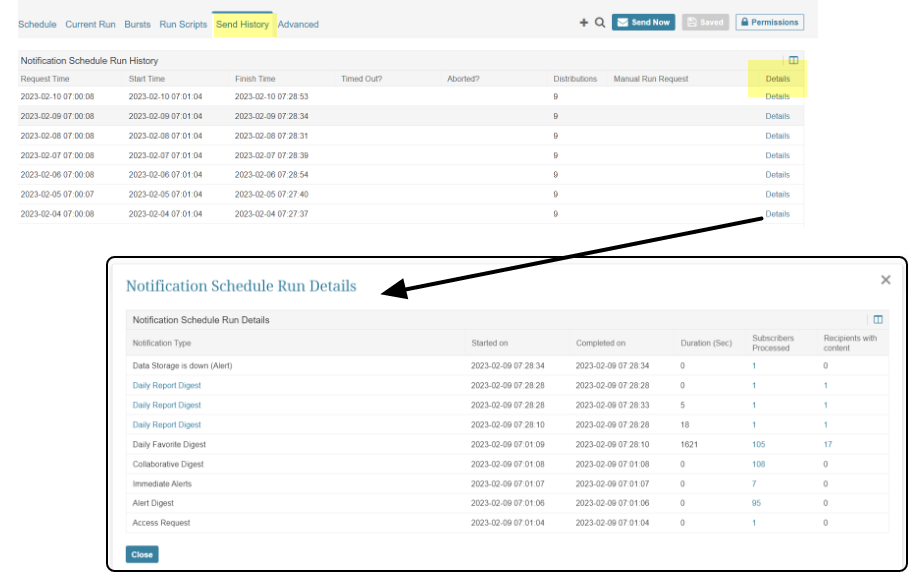Notification Schedules control when Notifications such as alerts, digests, and reports are distributed. This control includes the dates/times and the frequency that information will be delivered. Basic schedules can be created/modified directly on an element's editor when selecting a schedule. On the Notification Editor, more complex options are available to ensure all relevant data is processed or loaded prior to execution.
Two separate dependencies ensure that the data has been validated for correctness or that the data being notified has completed loading/processing.
Data Dependency: usually a simple SQL that is written to return either a Positive integer or a Date/Time to signal that data is valid
Trigger Dependency: verifies that Data processing is complete; such as waiting for an ETL or Report generator to complete within the same processing cycle as the Notification cycle.
These Dependencies and their additional options are only available on the Schedule Notification Editor as described in this article.
Access is restricted by security; see Security: Notification Schedule
1. Go to Admin > Distribution > Notification Schedules
- System opens the 'Notification Schedules ' list containing all existing schedules. To edit an existing schedule, click the 'Name' link in the grid to open the Notification Schedule Editor.
- If no emails are associated with a schedule, the schedule can be deleted from this page. Otherwise, it can only be deleted using the Notification Schedule Editor
- To add a new schedule, click the + New notification schedule button
2. Create a New Schedule - Simple Example
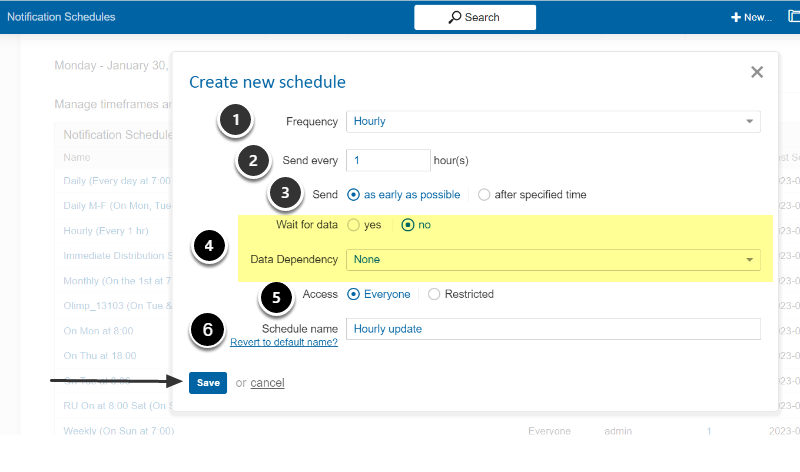
- Enter a Frequency using choices in dropdown
- A positive integer value for 'Send Every' field
-
Send:
- as early as possible: note that Metric Insights always processes data collection jobs prior to any Notifications.
- after specified time: will open a field for entering a time
- Wait for data and Data Dependency are explained here
- Access: indicate if Schedule is available for everyone's use or is restricted for your use only.
- Give your Schedule a unique Schedule Name
[Save] to open Notification Schedule Editor
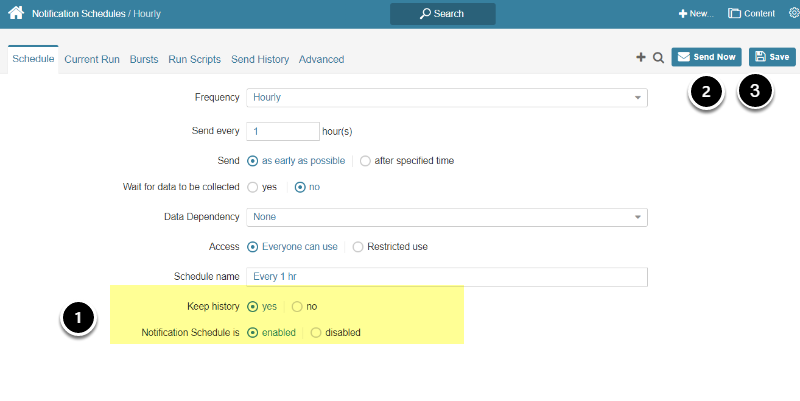
- Two additional fields will display values with system defaults. All existing fields may be changed in the Editor, but make sure to Save again after any changes.
- If Wait for data to be collected is set to "yes", additional fields will open; proceed to Dependencies
- [Send Now] will activate any Events running on this schedule immediately. You will receive a confirmation message of events scheduled to run.
- [Save] in upper right corner will be activated if any changes are made.
3. Dependencies
3.1. Adding a Data Dependency
A Data Dependency is a program you can create to allow checking for certain conditions to exist - See Create a Data Dependency for more information.
- Data Dependency: You can select any existing Data Dependency defined to the system. This schedule will not run until that event completes returning either a positive number or a valid date.
3.2. Adding a Collection Dependency
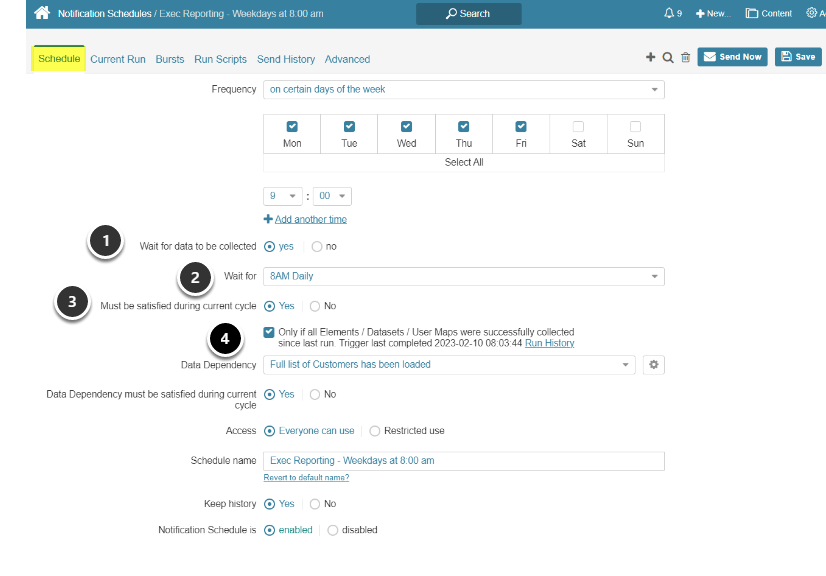
You can select any existing Data Collection Trigger in the system and this schedule will not run until those events running on that Trigger complete
- Wait for Data to be collected: Set to "yes" to open additional fields
- Wait for: Select any existing Data Collection Trigger from dropdown
- Must be satisfied during current cycle: Setting to "Yes" ensures that data collection was completed during the same processing cycle. This would prevent problems with reporting on "stale data", i.e. if the last time "8 am Daily" ran was yesterday but not today, this will prevent the schedule from executing.
- Note: you can not set a Schedule to run every day on Tuesday if it depends on a daily job run on Monday as they are not within the same daily cycle.
- Check this to ensure that all data was collected as Triggers can complete successfully even though some errors have occurred
4. Additional tabs (Daily Run example)
4.1. Current Run tab
- Shows results of last running of this schedule
- Click on any Recipient field to view a list of Users that received this Report, Digest, or Alert.
4.2. Bursts tab

Displays all Bursts in this Schedule and who received them. Click on a field in Recipients column to view details.
4.5. Advanced tab - Set Expire Run

- Expire run after: sets a maximum processing time for this schedule; system default is 600 minutes
- Abort processing if expired: a process may expire before all data is updated; unless you choose to Abort, any completed updates will remain
- If the Scheduled run is either expired or aborted, you can specify an email detailing the failure to be sent to designated User(s)
